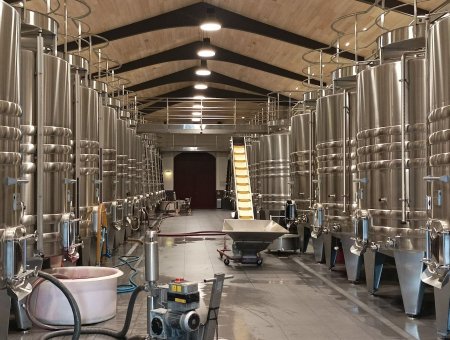Container for vinification and ageing
Wine containers play an essential role in the production of wines, whether during the fermentation phase, ageing, storage or conservation before bottling. In recent decades, technological advances and changes in viticultural practices have led to a veritable revolution in this field. Winegrowers now have a wide range of containers at their disposal, each offering specific advantages to meet a variety of technical and quality objectives.

Wine-making and ageing containers
A variety of materials to suit every need
Wine containers come in a variety of materials, each with its own special features:- Stainless steel : Renowned for its impeccable hygiene and aromatic neutrality, it is ideal for preserving fresh, delicate aromas, particularly in white and rosé wines. Stainless steel is also oxygen-tight and allows precise temperature control thanks to thermoregulation equipment.
- Concrete : Appreciated for its thermal inertia and limited porosity, concrete encourages natural micro-oxygenation of the wines, ideal for ageing. Available in a variety of shapes (ovoid, truncated cone, etc.), it is in keeping with an ancient tradition while meeting modern requirements.
- Wood : Used for centuries, wood, mainly oak, brings aromas and structure to wines through controlled oxygenation. Barrels and tuns are particularly popular for ageing.
- Resin and polyethylene: These modern, lightweight and economical materials are ideal for micro-vinification or storage. Their variable porosity can be used to soften wines while remaining easy to maintain.
- Glass, ceramic and stoneware: These emerging containers, such as glass or stoneware amphoras, offer perfect inertia and allow pure expression of the grapes, while remaining neutral and durable.
Varied shapes for specific uses
The shape of the containers has a direct impact on the quality of the wine and the winemaking process:- Cylindrical or square tanks: Suitable for large-volume vinification or storage.
- Truncated cone-shaped vats: Their conical shape favours concentration and extraction, particularly for red wines.
- Ovoid vats and amphorae : Inspired by Antiquity, these shapes encourage constant natural movement of the wine, ideal for maturing on fine lees and homogeneous fermentation.
- Barrels and tuns: Their small capacity (225 to 600 litres) makes it possible to work with micro-batches or to isolate specific cuvées for ageing.
Equipment and accessories to optimise vinification
Vats and other containers can be fitted with technical features to make the winemaker's work easier:- Hatches and doors : Simplify operations such as extracting the marc or punching down the cap.
- Tasting taps and racking valves: These allow precise control of sampling at different levels.
- Temperature control systems: Essential for controlling temperatures during fermentation and ageing.
A strategic choice for quality and innovation
The diversity of wine containers enables producers to adapt to a wide range of objectives:- Micro-vinifications and plot-by-plot selections: Small containers, such as barrels or low-capacity vats, encourage a tailor-made approach.
- Modern vinification : Large stainless steel or concrete vats make it easier to manage large volumes with a high degree of precision.
- Complex ageing: Wooden or ceramic barrels and vats bring unique organoleptic characteristics to the wines.
Wine containers are more than just vessels: they are essential tools for shaping the identity and quality of wines.












